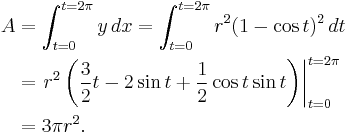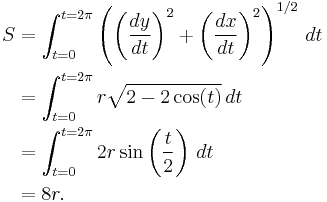Cycloid
A cycloid is the curve traced by a point on the rim of a circular wheel as the wheel rolls along a straight line. It is an example of a roulette, a curve generated by a curve rolling on another curve.
The cycloid is the solution to the brachistochrone problem (i.e. it is the curve of fastest descent under gravity) and the related tautochrone problem (i.e. the period of an object in descent without friction inside this curve does not depend on the object's starting position).
Contents |
History
The cycloid was first studied by Nicholas of Cusa and later by Mersenne. It was named by Galileo in 1599. In 1634 G.P. de Roberval showed that the area under one arch of a cycloid is three times the area of its generating circle. In 1658 Christopher Wren showed that the length of one arch of a cycloid is four times the diameter of its generating circle. The cycloid has been called "The Helen of Geometers" as it caused frequent quarrels among 17th century mathematicians.[1]
Equations
The cycloid through the origin, generated by a circle of radius r, consists of the points (x, y), with
where t is a real parameter, corresponding to the angle through which the rolling circle has rotated, measured in radians. For given t, the circle's centre lies at x = rt, y = r.
Solving for t and replacing, the Cartesian equation would be
The first arch of the cycloid consists of points such that
The cycloid is differentiable everywhere except at the cusps where it hits the x-axis, with the derivative tending toward  or
or  as one approaches a cusp. The map from t to (x, y) is a differentiable curve or parametric curve of class C∞ and the singularity where the derivative is 0 is an ordinary cusp.
as one approaches a cusp. The map from t to (x, y) is a differentiable curve or parametric curve of class C∞ and the singularity where the derivative is 0 is an ordinary cusp.
The cycloid satisfies the differential equation:
Area
One arch of a cycloid generated by a circle of radius r can be parameterized by
with
Since
we find the area under the arch to be
Arc length
The arc length S of one arch is given by
Cycloidal pendulum
If a simple pendulum is suspended from the cusp of an inverted cycloid, such that the "string" is constrained between the adjacent arcs of the cycloid, and the pendulum's length is equal to that of half the arc length of the cycloid (i.e. twice the diameter of the generating circle), the bob of the pendulum also traces a cycloid path. Such a cycloidal pendulum is isochronous, regardless of amplitude. The equation of motion is given by:
The 17th Century Dutch mathematician Christiaan Huygens discovered and proved these properties of the cycloid in the search to the design of more accurate pendulum clocks for use in navigation.[2]
Related curves
Several curves are related to the cycloid.
- Curtate cycloid: Here the point tracing out the curve is inside the circle, which rolls on a line.
- Prolate cycloid: Here the point tracing out the curve is outside the circle, which rolls on a line.
- Trochoid: refers to any of the cycloid, the curtate cycloid and the prolate cycloid.
- Hypocycloid: The point is on the edge of the circle, which rolls not on a line but on the inside of another circle.
- Epicycloid: The point is on the edge of the circle, which rolls not on a line but on the outside of another circle.
- Hypotrochoid: As hypocycloid but the point need not be on the edge of its circle.
- Epitrochoid: As epicycloid but the point need not be on the edge of its circle.
All these curves are roulettes with a circle rolled along a uniform curvature. The cycloid, epicycloids, and hypocycloids have the property that each is similar to its evolute. If q is the product of that curvature with the circle's radius, signed positive for epi- and negative for hypo-, then the curve:evolute similitude ratio is 1 + 2q.
The classic Spirograph toy traces out hypotrochoid and epitrochoid curves.
Use in architecture
The cycloidal arch was used by architect Louis Kahn in his design for the Kimbell Art Museum in Fort Worth, Texas. It was also used in the design of the Hopkins Center in Hanover, New Hampshire.
See also
Cited References
- ^ Cajori, Florian (1999). A History of Mathematics. New York: Chelsea. p. 177. ISBN 978-0821821022.
- ^ C. Huygens, "The Pendulum Clock or Geometrical Demonstrations Concerning the Motion of Pendula (sic) as Applied to Clocks," Translated by R. J. Blackwell, Iowa State University Press (Ames, Iowa, USA, 1986).
Other References
- An application from physics: Ghatak, A. & Mahadevan, L. Crack street: the cycloidal wake of a cylinder tearing through a sheet. Physical Review Letters, 91, (2003). link.aps.org
- Edward Kasner & James Newman (1940) Mathematics and the Imagination, pp 196–200, Simon & Schuster.
- Wells D (1991). The Penguin Dictionary of Curious and Interesting Geometry. New York: Penguin Books. pp. 445–47. ISBN 0-14-011813-6.
External links
- Weisstein, Eric W., "Cycloid" from MathWorld. Retrieved April 27, 2007.
- Cycloids at cut-the-knot
- A Treatise on The Cycloid and all forms of Cycloidal Curves, monograph by Richard A. Proctor, B.A. posted by Cornell University Library.
- Cicloides y trocoides
- Cycloid Curves by Sean Madsen with contributions by David von Seggern, Wolfram Demonstrations Project.
- Cycloid on PlanetPTC (Mathcad











